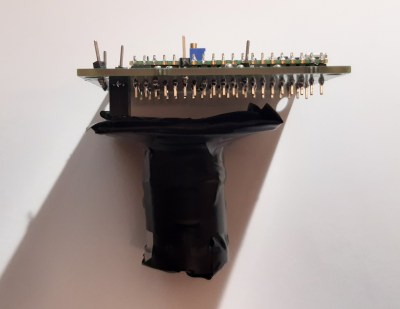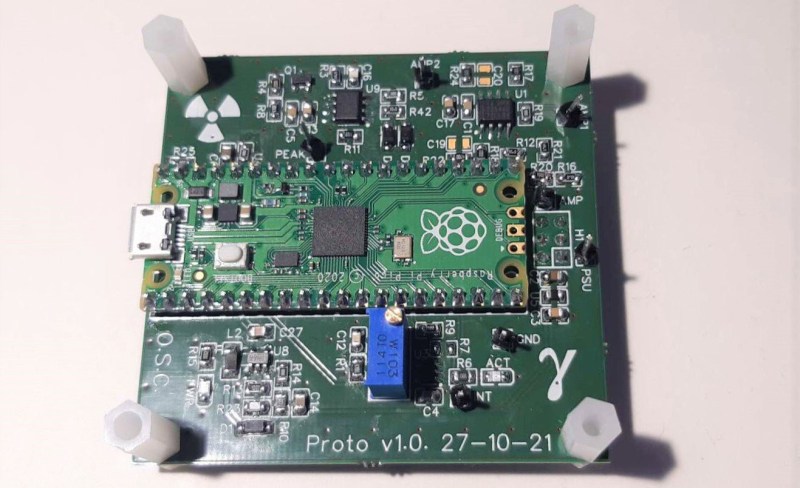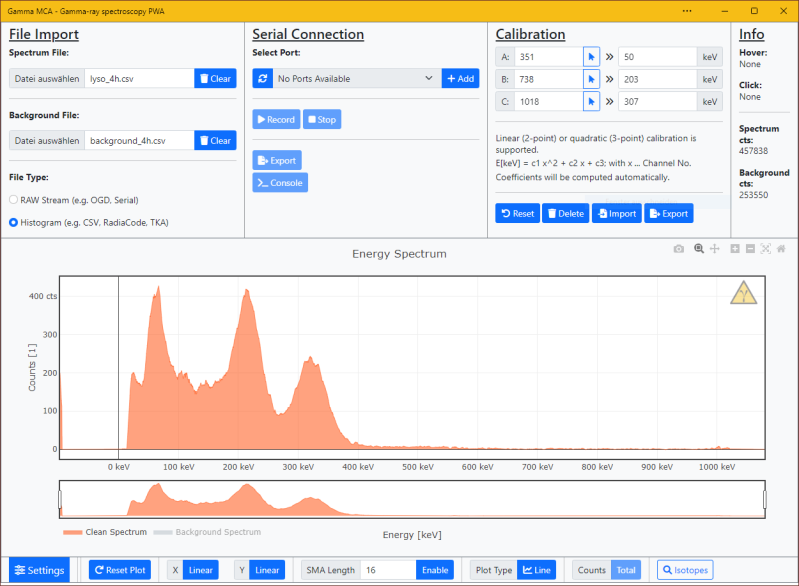If you’re a radiation enthusiast, chances are you’ve got a Geiger counter lying around somewhere. While Geiger counters are useful to detect the amount of radiation present, and with a few tricks can also distinguish between the three types of radiation (alpha, beta and gamma), they are of limited use in identifying radioactive materials. For that you need a different instrument called a gamma-ray spectrometer.
Spectrometers are usually expensive and complex instruments aimed at radiation professionals. But it doesn’t have to be that way: physics enthusiast [NuclearPhoenix] has designed a hand-held gamma spectrometer that’s easy to assemble and should fit in a hobbyist budget. It outputs spectral plots that you can compare with reference data to identify specific elements.

The heart of the device is a scintillation crystal such as thallium-doped sodium iodide which converts incoming gamma rays into visible light. The resulting flashes are detected by a silicon photomultiplier whose output is amplified and processed before being digitized by a Raspberry Pi Pico’s ADC. The Pico calculates the pulses’ spectrum and generates a plot that can be stored on its on-board flash or downloaded to a computer.
[NuclearPhoenix] wrote a convenient program to help analyze the output data and made all design files open-source. The hardest part to find will be the scintillation crystal, but they do pop up on auction sites like eBay now and then. We’ve featured an Arduino-based gamma spectrometer before; if you’ve always wanted to roll your own scintillators, you can do that too.

















Very cool! A quick search on eBay shows the scintillators going for anywhere from $200 to $1400 USD (https://www.ebay.com/sch/i.html?_from=R40&_trksid=m570.l1313&_nkw=NaI%28Tl%29+scintillator&_sacat=0) — anyone know if there’s a cheaper option?
plastic ones, like Bicron BC408 or BC412. They have the benefit of not being hygroscopic like NaI, but have much lower detection efficiency. Also the SIPM (the actual electronic detector) alone is $90 in single qty.
Plastic and liquid scintillators are of almost no use for spectroscopy. Spectroscopy requires that the entire energy of the photon be stopped by- (deposited in-) the scintillator. That energy is converted to light and the brightness of the flash is proportional to the energy. The stopping power of for gammas is mostly dependent on its atomic number – organics are poor, iodine is good, lead is very good so the iodine in NaI(Tl) does the stopping but even then 25mm is needed for Tc99m (140keV), 50mm for I131 (360 keV) and 100mm for Co60 (1250 keV).
The best source of good information on this is “Radiation Detection and Measurement by Glenn F Knoll”
I got mine used from Ukraine and Russia on eBay. Now is probably not the best time for that, but generally you can find many cheaper/used offers from that region. Might take a bit of patience though.
There are liquid scintillation cocktails used in biology a lot for about $500 a gallon/5L. You should be able to get 50 or 100ml from a university biology department for nothing.
I remember back to when I started working and being in charge of a lab testing thallium doped sodium iodide crystals, a good couple of thounsand of them, each about 1kg in weight.
How long it takes to grow them to that mass? Days, weeks?
I did not know until 2 minutes ago the word “pig” for a lead container so your comment really confused me :D
Lead Pigs are pretty easy to come by (Not Affiliated in any way):
LEAD PIG – Lead Lined Material Storage/Shipping Container – USED $7.50 + $12.50 Shipping.
https://www.ebay.com/itm/115039673228?chn=ps&norover=1&mkevt=1&mkrid=711-213727-13078-0&mkcid=2&itemid=115039673228&targetid=4580496732614414&device=c&mktype=&googleloc=&poi=&campaignid=418233788&mkgroupid=1230353745471221&rlsatarget=pla-4580496732614414&abcId=9300542&merchantid=51291&msclkid=7556cd6dfb861979cb9caf1e862d7887
ITEM: LEAD PIG – Lead Lined Material Storage/Shipping Container
Used Once
Verified non-radioactive
Was used in the Medical Industry for shipping patient tissue samples that were sealed in jars.
Plastic shelled lead lined material storage/shipping containers, known in the industry as ‘LEAD PIGS’, The internal container is a solid cast lead container fabricated for material containment. Safely store you’re, radioactive Isotopes, and other radioactive samples. The plastic shell protects you from physically touching lead, which is a toxic metal.
Features:
Locking Screw Cap
Rubber Seal to Prevent Leaking
Plastic Shell to Protect Physically Touching Lead
Capable of holding a 10 CC Vial (approximate)
Outer Dimensions (approximate)
3.50 Inches High
2.00 Inches Diameter
Inner Dimensions (approximate)
1.00 Inches Diameter
Lead Thickness (approximate)
.25 Inches
Weight (approximate)
1 Pound 4 Ounce
CONDITION: VERY GOOD
several mm of thickness per hour at most, doesn’t matter how long or wide. Also the bigger the crystal, the longer it takes to cool without cracking due to internal stress. My guess would be a week+ if the cooling is included.
Cool project. But there is a problem with such. Having a gamma spec leads to obtaining radioactive things to measure. I now have a small collection of than. Boo. But yay 😁
Now you’ll just have to build a pig. They’re not that hard.
Yeah I got my own little collection too now. But all-in-all you really don’t need conventionally “dangerous” things to sample for your devices. The good thing about scintillation counters is that they are much more sensitive at small activities than your usual Geiger counter, so things like an ionization smoke detector work great!
Haha, I’ve got my own little collection too now. The thing with scintillation counters/gamma spectrometers is that they are generally more efficient at detecting (low-activity) samples than your average Geiger counter, so you don’t need conventionally dangerous materials. An ionization smoke detector works great for Am-241 spectra for example!
I have a vacuum tube photomultiplier in a box in the garage.
I didn’t know solid state versions are available.
Around the time of Three Nile Island, there was a solid state detector in Popular Electronics, though it used some device that was probably most available from the author.
The Farm, the big commune in Tennessee, sold solid state “geiger cou ters” around then too. Though you were supposed to be able to use spiderwort plants to detect radiation.
Reading this article I looked on eBay and found: “Hamamatsu R7400U PMT Scintillation Tube”. (I’d post a link, but the HAD moderation system would put thepost in jail for several days).
For the price of $25 you can get the entire detector+crystal on a small PCB.
I might pick up a couple of these just to experiment with.
“Currently sold out”
2,934 available today (Wednesday). IM me on Hackaday and I’ll send you a full link.
Or type this number into the eBay search field: 194659036410
I have 5 of those and I’m working on a PSU right now.
That is a cool thing. Volume might be a bit small for good spectroscopy but an insane deal. Sadly no shipping internationally.
I saw them on sale a few weeks ago and picked one up. I just found this site while trying to locate a schematic for a gamma ray spectrometer. These posts are almost a year old. Has anyone had any luck using a R7400U to build one?
they’re pricey and have limited use outside of literally counting single photons of light
Yeah, they are great! Overall a much more attractive part to use in applications like this. They’re pricy though — the SiPM I’m using costs about 80€ per piece in very low quantities. However, I don’t know how they compare to the price of PMTs…
Cool project. Does the RP2040 poor ADC performance (~8.7 ENOB) affect the measurements?
Currently, I have to admit the RP2040 ADC did have some learning curve to get to know its quirks. I’m currently working on reducing noise as good as possible with a voltage reference, much better SiPM power supply and so on. But the thing that bothers me the most is the DNL issues with the four channels especially.
“and with a few tricks can also distinguish between the three types of radiation”
What are these tricks?
Fear, confidence, and strength? As opposed to the kinds of air.
Probably using paper to block Alpha particles, foil or metal to block Beta, and whatever is left is probably Gamma.
“Spectrometers are usually expensive and complex instruments aimed at radiation professionals.” – I thought you were supposed to aim them at the radioactive sample?
They are aimed at the Radiation Professionals of rogue nations (you know who you are!),
as it helps to discover what they are working with/on.
B^)
To distinguish between the different types, you can do something as simple as, put something in the way, as they have different penetration abilities. Vacuum, air, Paper, tinfoil, lead for example.
Different scintillators for different type of radiation are required – what is sensitive for alpha, is completely transparent to gamma. With beta, this trick will work with alu sheets. And then there is sensitivity for energy levels,QE, decay times and whole can of worms. Not as straightforward as with Geiger tube, after all you hunt for spectrum not just count events.
Exactly, and the type of scintillator that I used, so NaI doped with Thallium, is only really used with photons, i.e. gamma-rays. Generally, for high-energy particles (alpha, neutrons, protons, …) there are many better types of material like tons of plastic scintillators for example.
Paper will work for alpha radiation, thin metal for beta and lots of lead for gamma
Hmmm, what does a vacuum stop, and how do we know?
I found a guy though, so could get some to experiment, selling cheap lab quality vacuum, 10000 litres for $5, best of all, to save a fortune on shipping, he compresses it into a small vial and you just need to expand it to use it.
;-)
I was employed part time by a small company in Oak Ridge TN back in the ’80s and we would get large blocks of scintillation plastic, wrap them up tightly with aluminum foil and Scotch Tape then couple them to a photomultiplier tube using K-Y jelly, and they made fine detectors for scanning contaminated metals for recycling companies! The little company sold quite a few and I suppose they are still working…